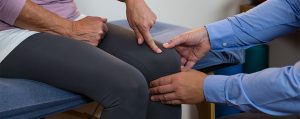I’m a Physical Therapist, and These Are 3 Reasons Why I Swear By Dry Needling For My Patients
Posted on by Peter Batz, PT, DPT, OCS, CMTPT, AIB-VRC
When someone comes to physical therapy, what exactly are they looking for? The likely answer is to feel better in the quickest amount of time possible. As a new physical therapist, I often opted for manual therapy techniques to help relieve muscle tightness for my patients. Then, I started to add an instrument-assisted technique called Graston to the mix. I later learned about dry needling from my manager, and I saw many of my patients benefit from adding dry needling to their plan of care. What exactly is dry needling, though? And is it right for you?
(more…)
Heart Healthy: Take Care Of Your Body’s Most Important Muscle
Posted on by Zachary Vandenberg, DPT
Your heart is the body’s most vital muscle. Maintaining a heart-healthy lifestyle is essential for overall well-being, and physical therapists (PTs) play a crucial role in addressing cardiovascular concerns and overcoming pain barriers that may hinder exercise.
(more…)
More Than Kegels: 4 Things You Didn’t Know About Pelvic Health Physical Therapy
Posted on by Jaclyn Cecere PT, DPT, OCS
Everyone has pelvic floor muscles that support their pelvic organs, help you control bowel and bladder functions, and aid in sexual functions. These muscles can be exercised like any other muscle in your body. When you think about pelvic floor exercises, most people think of Kegels, but you might be surprised to learn that not everyone should do them. There are many causes of pelvic floor dysfunction, thus, many reasons why one might seek pelvic health physical therapy. Some common conditions that can be treated with the help of a pelvic health physical therapist include urinary or fecal incontinence, constipation, frequent urination, pelvic organ prolapse, pelvic pain, sexual dysfunction, pain with intercourse, and issues experienced both pre- and postpartum.
(more…)
Breaking The Back Pain Cycle: The Science Behind Exercise And The Role Of Physical Therapy
Posted on by Brian Chapman DPT, OCS, CSCS, CF-L1
Back pain is a common ailment affecting millions worldwide, impacting their daily lives and overall well-being. It is the single largest cause of disability worldwide. One frequently asked question is whether exercise can relieve this persistent discomfort. In this blog post, we'll explore the relationship between exercise and back pain, shedding light on how physical activity can be a powerful tool in managing and preventing this prevalent issue. Additionally, we'll delve into the crucial role that physical therapists play in guiding individuals toward the right exercises for effective back pain relief.
(more…)
5 Reasons Why Dry Needling Isn’t As Scary As You Think
Posted on by Zachary Vandenberg, DPT
The word "needling" might make some feel hesitant about the world of dry needling, but dry needling isn’t as scary as it sounds. In fact, it could be the key to unlocking a pain-free and healthier you. Let's dive into the world of dry needling and explore why it's not as intimidating as you might think.
(more…)
A Guide to a Bullet Proof Core for Overhead Athletes
Posted on by Paige Gibbens, PT, DPT, MHA
While overhead sports rely heavily on our upper extremities (shoulders, elbows, and wrists), the core is often forgotten as a critical piece of the puzzle for success in sports with a high overhead demand. Many facets of the core contribute to overhead movements and strength. The core stabilizes the body from the legs up. Because the shoulder is a less stable joint by itself, maintaining a strong core is important for athletes such as pitchers and throwers.
(more…)
Can Physical Therapy Help My Menopause?
Posted on by Alicia Bothell PT, DPT, PCES, CDNT, ATC-R
You probably know about “typical” menopause symptoms – trouble sleeping, mood swings, and hot flashes are a few that come to mind right away. Did you know that your pelvic floor undergoes changes as well? Read on to learn how pelvic health physical therapy (PT) can help with these changes!
(more…)
Bleeding Disorders: How Can They Impact My Pregnancy, And How Can PT Help?
Posted on by Amanda M Kilgore PT, DPT
Bleeding and clotting disorders affect many people in the United States and throughout the world. When someone has a bleeding disorder, their blood often clots too slowly, which can lead to complications throughout the body.
Pregnancy adds new considerations if you have already been diagnosed with a bleeding disorder. Staying in close contact with a physical therapist can help keep you safe and healthy during your pregnancy.
(more…)
